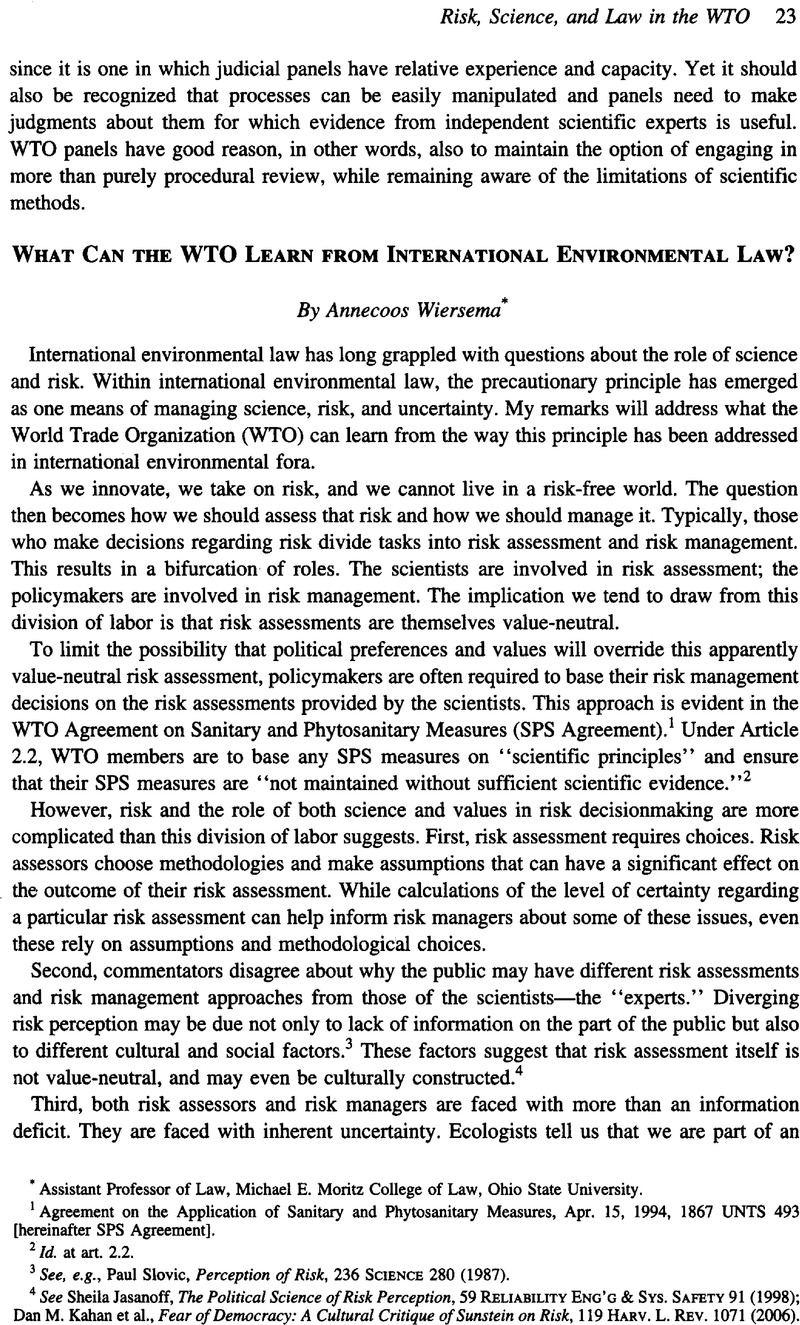No CrossRef data available.
Article contents
What Can the WTO Learn from International Environmental Law?
Published online by Cambridge University Press: 28 February 2017
Abstract

- Type
- Risk, Science, and Law in the WTO
- Information
- Copyright
- Copyright © American Society of International Law 2010
References
1 Agreement on the Application of Sanitary and Phytosanitary Measures, Apr. 15, 1994, 1867 Unts 493 [hereinafter Sps Agreement].
2 Id. at art. 2.2.
3 See, e.g., Slovic, Paul, Perception of Risk, 236 Science 280 (1987)CrossRefGoogle ScholarPubMed.
4 See Jasanoff, Sheila, The Political Science of Risk Perception, 59 Reliability Eng’G & Sys. Safety 91 (1998)CrossRefGoogle Scholar; Kahan, Dan M. et al., Fear of Democracy: A Cultural Critique of Sunstein on Risk, 119 Harv. L. Rev. 1071 (2006)Google Scholar.
5 See Wiersema, Annecoos, A Train without Tracks: Rethinking the Place of Law and Goals in Environmental and Natural Resources Law, 38 Envtl. L. 1238, 1246 (2008)Google Scholar.
6 Rio Declaration on Environment and Development, para. 15, Un Doc. A/CONF.151/5/Rev. 1 (June 13, 1992), reprinted in 31 ILM 874. Even critics of the principle do not necessarily object to the Rio Declaration’s formulation of the principle. See Cass Sunstein, Laws of Fear: Beyond the Precautionary Principle 18, 23-24 (1993).
7 Shaffer, Gregory, A Structural Theory of WTO Dispute Settlement: Why Institutional Choice Lies at the Center of the Gmo Case, 41 NYU J. Int’l L & Pol. 1, 62 (2008)Google Scholar.
8 Panel Report, European Communities—Measures Affecting the Approval and Marketing of Biotech Products, at 340-41, WT/DS291/R, WT/DS292/R, WT/DS293/R (Sept. 29, 2006) (adopted Nov. 21, 2006) [hereinafter Biotech].
9 Id. at 341-42.
10 Wiersema, Annecoos, Adversaries or Partners? Science and the Precautionary Principle in International Wildlife Treaty Regimes, 11 J. Int’l Wildlife L. & Poly 211, 218 (2008 CrossRefGoogle Scholar).
11 Appellate Body Report, European Communities—Measures Concerning Meat and Meat Products (Hormones), at 46, WT/DS26/AB/R, WT/DS48/AB/R (Jan. 16, 1998) (adopted Feb. 13, 1998).
12 SPS Agreement, supra note 1, at art. 5.7.
13 Id.
14 Conference on Environment and Development, June 3-14, 1992, Convention on Biological Diversity, 31 ILM 818, 822 (June 5, 1992) [hereinafter CBD]; Wiersema, supra note 10, at 220-21.
15 Convention on Biological Diversity, prin. 6, Dec. Vii/11 (CBD Cop7, 1994).
16 Cartagena Protocol on Biosafety to the Convention on Biological Diversity, Un Doc. UNEP/CBD/ExCOP/1/ 3, reprinted in 39 ILM 1027 (Jan. 29, 2000).
17 UN Env’t Programme & Secretariat of the Convention on Biological Diversity, Biosafety and the Environment: an Introduction to the Cartagena Protocol on Biosafety 6 (2003).
18 Convention on International Trade in Endangered Species of Wild Fauna and Flora, Mar. 3, 1973, 27 Ust 1087, 993 Unts 243. See Wiersema, supra note 10, at 223-28.
19 Framework Convention on Climate Change (UNFCCC), May 7, 1992, 31 ILM 849 (entered into force Mar. 21, 1994); Kyoto Protocol to the Unfccc, Dec. 10, 1997, 37 ILM 22 (1998) (entered into force Feb. 15, 2005).
20 Biotech, supra note 8, at 341.


